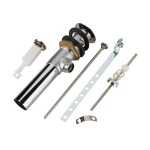Thermal Pads for Heat Sinks: Understanding Their Importance and Applications
Thermal pads are an essential component in many electronic devices, playing a crucial role in ensuring efficient heat dissipation from components like CPUs, GPUs, and other heat-generating components. They act as a bridge between the heat sink and the heat source, allowing for the transfer of heat away from the component, preventing overheating and potential failure.
Thermal pads are made of various materials, each with unique thermal properties. They typically comprise silicone-based compounds, possessing excellent thermal conductivity and flexibility, making them suitable for uneven surfaces. Other materials like graphite, ceramic, and phase-change materials are also employed depending on specific application requirements.
Importance of Thermal Pads in Heat Sink Applications
Thermal pads are vital for achieving effective heat dissipation in electronic devices, ensuring optimal performance and longevity. Here's why they are integral in heat sink applications:
1. Enhanced Thermal Conductivity: Thermal pads act as a thermal interface material (TIM), facilitating the transfer of heat from the component to the heat sink. Their high thermal conductivity ensures efficient heat flow, preventing heat buildup within the component and mitigating performance degradation.
2. Improved Contact Area: The flexible nature of thermal pads allows them to conform to uneven surfaces, creating a larger contact area between the heat source and the heat sink. This enhanced contact improves heat transfer efficiency, reducing thermal resistance and minimizing the temperature difference between the two components.
3. Reduced Thermal Resistance: The presence of air gaps between the heat sink and the component can significantly hinder heat dissipation. Thermal pads eliminate these gaps, minimizing the thermal resistance and enhancing heat transfer. They effectively bridge the gap between the two surfaces, ensuring a more efficient heat transfer path.
Factors to Consider When Selecting Thermal Pads
Choosing the right thermal pad is crucial for optimal heat dissipation. There are several factors to consider when selecting a thermal pad for a specific application:
1. Thermal Conductivity: Thermal conductivity is a measure of a material's ability to transfer heat. A higher thermal conductivity value ensures efficient heat transfer from the component to the heat sink. The desired thermal conductivity depends on the application and the temperature difference between the heat source and the heat sink.
2. Operating Temperature Range: Different thermal pads have varying operating temperature ranges. It is essential to select a pad that can withstand the expected temperatures of the application, considering the maximum operating temperature of the component and the heat sink.
3. Thickness: The thickness of the thermal pad influences the contact area and the overall thermal resistance. A thicker pad provides a larger contact area, improving heat transfer but also increasing thermal resistance. The ideal thickness depends on the application and the desired level of pressure between the heat source and the heat sink.
4. Compression Set: Compression set refers to the permanent deformation of the thermal pad under pressure. It is important to select a pad with a low compression set, ensuring that it maintains its shape and contact area over time, even under sustained pressure.
5. Compatibility: The thermal pad should be compatible with the materials of the heat source and the heat sink. Some materials may react negatively with the pad, causing degradation or affecting its performance. Compatibility should be carefully considered to ensure long-term reliability.
Applications of Thermal Pads in Electronics
Thermal pads are widely used in various electronic devices, including:
1. Computers and Laptops: Thermal pads are crucial for cooling CPUs, GPUs, and other high-power components in computers and laptops. They ensure efficient heat dissipation, preventing overheating and maintaining optimal performance.
2. Smartphones and Tablets: Thermal pads are also used in mobile devices to cool down the processor and other heat-generating components. They help to prevent overheating, ensuring seamless performance and extending the device's lifespan.
3. Servers and Data Centers: In server racks and data centers, thermal pads are essential for cooling high-density computing equipment. They facilitate efficient heat dissipation, preventing system failure and ensuring reliable operation.
4. Automotive Electronics: Automotive electronics, such as engine control units (ECUs), power inverters, and other components, often utilize thermal pads for heat dissipation. They help to manage the heat generated by these components, ensuring optimal performance and reliability under demanding conditions.
5. Industrial Equipment: Thermal pads are also employed in various industrial applications, including robotics, power electronics, and process control systems. They help to regulate temperatures in critical components, ensuring safe and efficient operation in demanding environments.
In conclusion, thermal pads are essential components in various electronic and industrial applications, playing a crucial role in efficient heat dissipation and ensuring optimal performance and longevity of devices. Understanding the function, importance, and selection factors of thermal pads is vital for engineers and designers involved in thermal management of electronic devices.

Thermal Pads Vs Paste Best Solution For Mounting Heatsinks On A Pcb Blog Altium Designer

100pcs 10 0 5mm Thermal Pad Gpu Cpu Heatsink Cooling Conductive Silicone P Zw Uk

How To Install A Thermal Pads On An M 2 Ssd Pad Aok

Thermal Interface Materials Experts And Supplier Pad Used Between Ic Heatsink

Thickened Thermal Conductive Silica Gel Pad Size 10x10x6mm At Best

Thermal Pad Gpu Conductive Interface Material Cpu Heatsink Cooling Factory Produced 0 5mm To 10mm 1 12w M K Hot S

Noise Reducing Thermal Pad Interface Materials

Example Of Thermal Design For Electronics Using The Gap Pad Scientific Diagram
Thermal Pads Conductivity 1 0 15 W M K For Cpu Laptop Led Mother Board Power Supply Heat Sink Pc 1mm 12mm Manufacturers And Suppliers China Factory Xiamen Naikos New Material Co Ltd

0 3mm 2mm Laptop Coppers Sheet Plate Strip Shim Thermal Pad Heatsink







